Click On Image
For Full Size Image |
Size |
Image Description |
Contributed
By |
 USNS Barrett (T-AP-196) USNS Barrett (T-AP-196)
|
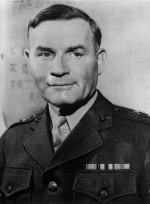 |
178k |
Namesake
Major General Charles Dodson Barrett, the first Commanding General of the 3d Marine Division, was awarded the Distinguished Service Medal posthumously in recognition of his outstanding service during World War II. He was killed accidentally while on duty in the South Pacific, 8 October 1943. General Barrett was born 16 August 1885, at Henderson, Kentucky. He graduated from high school in Alexandria, Virginia, and was commissioned a Marine second lieutenant on 11 August 1909. He was assigned duty at the Marine Officers School, Port Royal, South Carolina, the following month. In January 1911, he began a few months duty at the Marine Barracks, Boston, Massachusetts, and was detached on 23 May to report to the U.S. Naval Academy, Annapolis, Maryland, to command the Marine detachment aboard the USS Indiana. On 3 September of that year he transferred to the USS New Jersey. The general landed with the detachment of the USS New Jersey at Vera Cruz, Mexico, on 22 April 1914, and participated in the capture of that city. He was detached from that ship 13 December to the Marine Barracks, Norfolk, Virginia. His World War I duty included detached service with the U.S. Army in France from 25 September 1918. He participated in the Meuse-Argonne Offensive of November 1-3, of that year, and in the spring of 1919 was in command of the 2d Battalion, 367th Infantry at LeMans, France. Detached in April, he reported to the Commanding General, 4th Brigade, Marines, at Nieder Bieber, Germany, and was detailed as Adjutant from 11 April. He arrived back in the United States 3 August 1919.
From 1921-1922, General Barrett served in Santo Domingo and from 1924-27 was a member of the American Battle Monuments Commission, Washington, D.C. He then returned to France to study at the Ecole de Guerre in Paris, and from 1929-33 served as an instructor at the Marine Corps Schools, Quantico, Virginia. During the next two years, he was assigned to the Division of Operations and Training, Headquarters Marine Corps, Washington, and from 1935-36 served aboard ship as Division Marine Officer of Battleship Division 4, U.S. Battle Force. Upon completion of sea duty with the Battle Force, the general spent two and one-half years in the War Plans Section, Office of the Chief of Naval Operations, Washington, D.C.; and from August 1939 to June 1940, commanded the 5th Marines, 1st Marine Brigade, Fleet Marine Force. He returned to Headquarters, Washington, in July 1940, serving first as Director of the Division of Plans and Policies. Later, he served as Assistant to the Commandant of the Marine Corps, Lieutenant General Thomas Holcomb, from November 1941 to March 1942. In March 1942, General Barrett assumed command of the 3d Marine Brigade, and the following month embarked with the Brigade for Samoa, where he welded his command into a fighting unit. He was ordered to the United States in September 1942 to assume command of the 3d Marine Division, then being organized at Camp Elliott, San Diego, California, and was promoted to major general on assuming this command. Early in 1943, he embarked with elements of the 3d Marine Division for Auckland, New Zealand. By August 1943, he had all the major units of his division stationed on Guadalcanal, training intensively for the Bougainville operation. On 15 September 1943, General Barrett relinquished command of the 3d Marine Division and assumed duties as Commanding General of the First Marine Amphibious Corps, with headquarters on Noumea, New Caledonia. In this capacity, he continued with the planning for the assault on Bougainville until his death three weeks later. Accidentally injured following a cerebral hemorrhage, he died 8 October 1943 at the base hospital and was buried in the American cemetery there. Following the war, he was reinterred in Arlington National Cemetery.
Biography and Image from the USMC History Division |
Bill Gonyo |
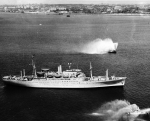 |
940k |
USNS Barrett (T-AP-196) originally designed for the American President lines and was launched 27 June 27, 1950 as the
SS President Jackson. With the outbreak of the Korean conflict, this modern designed passenger liner was designated for service with the Military Sea
Transportation Service. Probably the most outstanding popular feature of Barrett is her complete air-conditioning.
Facilities include a barber shop, diet kitchen, soda fountain, laundry, library, lounges, sick bay, operating room, x-ray room, bacteriological laboratories, a nursery
and formula preparation room for dependent children. Storage spaces for ship’s supplies, food, fuel, and equipment permit the ship a cruising range of over 10,000
miles.
US Navy photo #330-PS-2814 |
National Museum of the US Navy |
 |
74k |
USNS Barrett (T-AP-196) underway, date and location unknown.
US Navy photo |
William Zarkas, Retired MSC Boatswain
President, MSC Retiree Association |
 |
95k |
USNS Barrett (T-AP-196) underway, date and location unknown.
US Navy photo from the 1966/67 Edition of "Jane's Fighting Ships" |
Robert Hurst |
 |
42k |
USNS Barrett (T-AP-196) underway, circa 1953, location unknown.
US Navy photo |
Robert Hurst |

092219615 |
119k |
USNS Barrett (T-AP-196) tied up at Naval Station Guam in 1954.
Photo from www.flickr.com by Wing attack Plan R |
John Spivey |
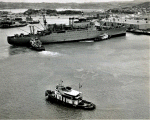
092219616 |
157k |
Three U.S. Army tugboats maneuver USNS Barrett (T-AP-196) into her berth at Naval Station at Naha, Guam in 1958
FLICKR U.S. Army Transportatin Museum |
John Spivey |

092219611 |
240k |
USNS Barrett (T-AP-196) passing under the Golden Gate Bridge while inbound to San Francisco Bay, date unknown.
US Navy MSTS photo |
Nicholas Tiberio |

092219612 |
246k |
USNS Barrett (T-AP-196) underway in San Francisco Bay, date unknown.
US Navy MSTS photos |
Nicholas Tiberio |

092219613 |
180k |

092219614 |
176k |
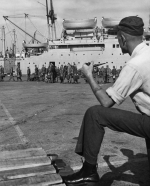 |
578k |
Under the watchful eye of a US Navy boatswain's mate, this contingent of US Army troops boards USNS Barrett (T-AP-196) at
Naval Supply Center, Oakland, CA., 25 October 1965.
US Navy History and Heritage Command photo # L45-20.05.01. |
US Naval History and Heritage Command |
 |
73k |
USNS Barrett (T-AP-196) departs Tacoma, WA., 8 June 1968, carrying US troops to Vietnam. This voyage was the last scheduled
military sealift of passengers from the continental United States.
US Navy MSC photo. |
Robert Hurst |
 TS Empire State V TS Empire State V
|
 |
47k |
Ex-USNS Barrett (T-AP-196) as TS Empire State V off Fort Schuyler, NY in front of the Throgs Neck Bridge, circa 1973 to 1990. During that time she served as school ship for SUNY Maritime College |
Christopher Wm Fogarty Class of 1979 SUNY Maritime College |

092219610 |
162k |
TS Empire State V lying at anchor in the Firth of Forth with a pilot on board, presumably about to weigh and proceed to a
berth at nearby Leith, the port of Edinburgh, Scotland, circa June 1987. |
Photo by Chris Woods |
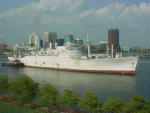 |
54k |
Ex-TS Empire State V makes her last voyage while under tow in Hampton Roads as she is moved from the James River Reserve Fleet anchorage to Bay Bridge Enterprises, Chesapeake, VA, for scrapping, 18 July 2007 |
Photo by Mabel Clark |















